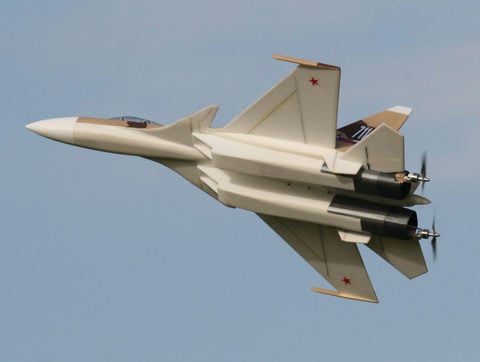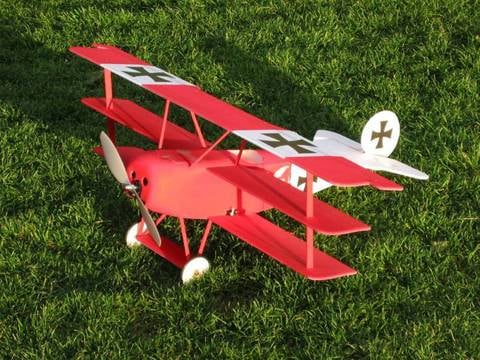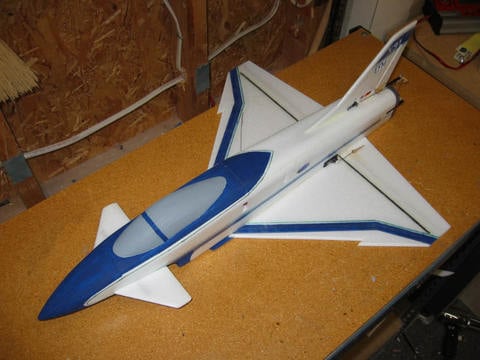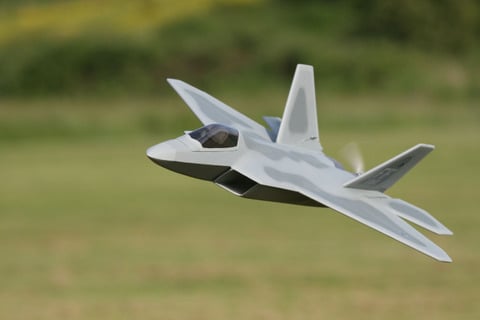Frequent visitors to Parkjets probably already knows the name Steve Shumate. His designs have been featured in multiple print magazines and continue to be very popular on Parkjets. Some even call him the "godfather of parkjets." Since Steve's designs are by far the most popular download on our site and since we started this interview series, we figured we would shoot him an E-mail. Well, we reached out to Steve and asked if he would be willing do a small interview with Parkjets and he agreed! So sit back and enjoy a little insight from one of the best designers of RC Parkflyers out there...Steve Shumate.
Steve, although we always think everyone knows your name is synonymous with parkjet designs, a lot of our readers are brand new to the RC hobby. Can you give us just a little background information?
Sure. I've been flying RC for 30 years now. I built my first RC airplane back when I was a teenager and taught myself how to fly (it was a 2-meter sailplane, so wasn't too hard). I've been an airplane nut my whole life, and built plastic models, free flight models, and control line models before graduating up to RC. I got my full scale pilot license when I was 18, and then went to college and earned a degree in Aerospace Engineering. I was hired by the Boeing Company right after graduating, where I still work today. I've been lucky enough to spend my whole career in Product Development at Boeing, and helped design many Boeing jets that never got built (600-seat double deckers, new versions of the 747, Sonic Cruiser), and a few that did (777-300ER, 787). I worked on the 787 from Day 0 on the program and am still working on the 787 today. My current job is in Product Strategy, where I help figure out what new versions of the 787 Boeing should develop in the future.
That's an amazing career so far. Being able to do what you love and all at a company that is on the front line in passenger flight on a global scale.
I'm sure a lot of our readers are envious of all the really awesome projects you have had a hand in shaping. With such a heavy workload and family, do you manage to get out and fly anymore?
A little, but not a lot. I've got two small kids at home, and family takes up much of my free time these days. I'm sure I'll get back into the hobby more once they're older.
That's understandable. When you have a few kids, your priorities shift and we see it all they time in hobbyists. Many visitors to Parkjets have been out the hobby for 20 years and then get the itch again.
Even though the hobby has taken a little bit of a back seat for you...you've been pretty active on the RC forums out there, and we haven’t seen any designs out of your shop in a while. Do you have any desire to get behind the CAD software and begin designing again? We know if you did, the buzz around whatever you designed would be tremendous. In some ways it would be like long awaited sequel to a blockbuster movie.
I DEFINITELY have the desire to design new airplanes, but just don't have much free time right now. That said, I always have a project or two on the back burner that I like to tinker with when I get the time. Can't let my CAD skills get too rusty!
We will get our popcorn ready when you give us the word! The nutty thing about CAD software is that it is getting easier and more consumer friendly all the time. The Google Sketch Up product is a fantastic example of some consumer friendly software. But we know what you mean, with the rapidly changing world of software, it's easy to get rusty. We hope you decide to knock the rust off soon!
One of the great things about your designs is that so many others have taken them and modified them a little with the help of CAD. Are you surprised that your designs really sparked so many other hobbyists to take their ideas and put them down on paper (or CAD)? It just seems like your designs shifted so many people’s thought process in terms of using a new material like depron foam to create scale models that performed well and look great.
Yes, I'm continually amazed at how popular some of my designs have become, and feel quite honored. I certainly didn't invent parkjets or Depron scale models, I just borrowed some good ideas from others before me and integrated them together. To me, much of the credit for how popular my designs have become goes to RC Groups, which makes it so easy for folks to share their work and discuss it with others. It's where I learned most of what I know about foam RC models, and where I've then shared my new ideas. And of course other RC forums from around the world link to and borrow stuff from RC Groups, expanding the influence.
We have to say that we have spent our fare share of time browsing RC Groups, reading through the mountains of threads and questions. It's one of the best resources out there.
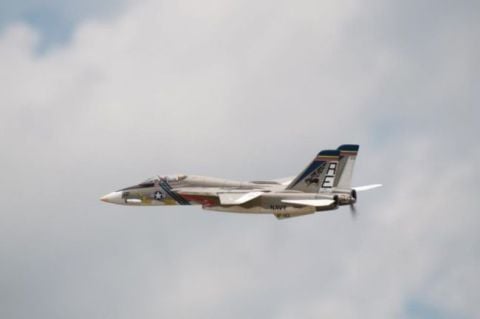 Steve Shumate F-14 TomcatYour designs continue to be very popular on Parkjets, and we know they are flying all across the world. In the fast evolving world of RC Airplanes, your designs have stood the test of time. Why do you think your designs have had such lasting power?
Steve Shumate F-14 TomcatYour designs continue to be very popular on Parkjets, and we know they are flying all across the world. In the fast evolving world of RC Airplanes, your designs have stood the test of time. Why do you think your designs have had such lasting power?
I think a key reason is the balance they strike between being quick building vs. semi-scale. True scale models tend to be complicated to build and challenging to fly, yet quick-building flat foam models fly great but tend to not look very scale. So I've tried to find a good balance between those two competing design goals in all my designs. I'm also not afraid to deviate slightly from scale to improve flying qualities, things like enlarging tails for more stability or making small wing planform changes to reduce tip stall. Nearly all of my designs have tails that enlarged about 10-20% from scale, for example. Scale looks are important, but not as important as buildability or flyability in my book!
As any RC pilot can attest, crashing a scale plane feels no different than one that has a slightly larger tail. Flyabilty is absolutly key. I'm sure you know that your F-14 and F-22 are very popular designs and continue to be some of the most downloaded plans on our site.
In fact, last month, out of the top 10 designs downloaded, you had four (SU-37, F-14, Super Bandit, and F-22). But just down the list is a design that doesn't get a lot of discussion, the Boeing Sonic Cruiser. We know you have a personal connection to the design, can you just briefly tell us about your personal connection?
Yes, I was the Configuration Design lead for the Sonic Cruiser. I was responsible for integrating the aerodynamics, structures, and payloads elements, and then developing the overall design of the airplane. It was one of the most fun times of my career! The Sonic Cruiser broke new ground in many areas, and was an airplane engineer's dream to work on. Lots of design challenges looking for innovative solutions. But as you probably know, the market eventually shifted toward fuel efficiency over speed, so Boeing ended up putting much of that new technology into a slower airplane that eventually became the 787. So once the Sonic Cruiser project was cancelled, all of the engineers like me simply transitioned over to the 787.
The Sonic Cruiser is by far your simplest design, especially when compared to say your SU-37. The Sonic Cruiser is really just a profile type parkjet with twin power and working canards, which makes it very unique.
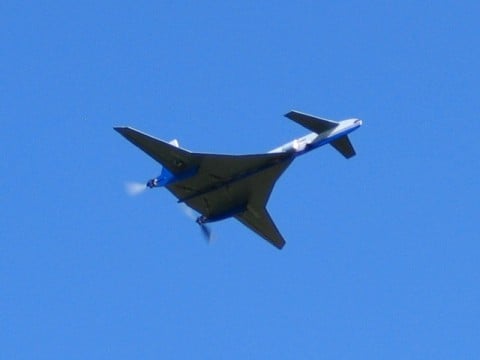 Steve Shumate Boeing Sonic Cruiser
Steve Shumate Boeing Sonic Cruiser
Do you have any advise for builders out there wanting to build the Sonic Cruiser?
It took two prototypes to get a Sonic Cruiser model that flew well, but the final design is really a pussycat in the air and easy to fly. The key advice I can give is to be careful to ensure the two motors are perfectly matched, which is standard advice on twin-engine models. Also make sure to keep the weight down.
The Sonic Cruiser looks so good in the air. We sure wish the real thing was built and flying! Another popular design is your SU-37. By far this is the most impressive model we have seen, just in terms of pulling it out at the flying field. It always get a lot of attention. But what design are you most proud of? I mean, everyone loves the F-22, but even your Fokker DR1 is a very cool design too.
I'd say the Su-37 is the design I'm second-most proud of. The first has to be the F-14. It took a lot of hours behind CAD to figure how to make that model easy to build yet scale-looking and good flying. The wing swing mechanism was an especially challenging part of that design. I also had to make some tough calls on the scaleness of the model, such as losing the characteristic canted engine inlets to greatly simplify construction. But the best part was the prototype flew perfect from the first flight on, no design modifications were needed. That said, if you ask which of my designs that I personally fly the most, it would be the Fokker DR1. It's simply a blast to fly that model. I love how it can be flown slow and scale-like one minute, and then do harriers and hovering the next. Plus it requires only the smallest of flying fields, so I can fly it anywhere.
Love the Fokker. It's so stable in flight and a great change of pace from the jet designs. But you are probably right, the F-14 has such an impact with the swing wings, a real engineering victory!
What continues to amaze us at Parkjets is that so many of our users are first time builders. With all the out of the box (RTF) models coming out every week, we just can’t believe there are so many out there that still want to get their hands dirty, create their own model. There is a certain satisfaction, we think, to starting with an empty work bench and completing a project. And for you, the satisfaction must be 100 fold, given that you know that thousands and thousands of modelers have taken your designs and had so much fun. Why do you think there is this base desire for modelers to keep building?
I agree 100%--nothing compares to the feeling of starting with a few flat sheets of foam on your work bench and then turning them into a great flying and scale-looking model airplane. RTFs can't begin to compete with that level of satisfaction in my book. And yes, I'm especially thrilled that my work has encouraged others to try their hand at building from scratch rather than just owning RTFs. RTFs have their place and I certainly own a few, but I don't feel anywhere near the connection with those models as I do with the ones I built myself.
It's funny you say that, because in some ways a scratch built RC airplane is like an old car. You just get connected to those models that you have a hand in building and creating. Like that old car that you have replaced a few parts on, kept it going over the years, and talk in to starting on a cold morning. It's very satisfying!
Over the last few years, we have seen a rapid expansion of EDF, and we get asked this all the time, "How can I adapt an EDF set up to one of the Steve Shumate models?" Do you have any advise for builders wanting to convert your plans to EDF?
Yes, many of my designs lend themselves quite well to EDF conversion--and many of my later designs I specifically designed with that in mind. However, EDFs aren't easy to get to work well. To have a good-flying EDF, the power system (fan diameter, motor, battery) must be precisely matched to the airframe (wing sizing, weight, inlet area, exhaust area. If you just plunk a fan unit into a model (including my park jets), the chances of success are minimal. At minimum you've got to pick the right size power system and verify or modify the airframe design to provide the proper inlet and exhaust sizing. I've designed two EDF models (Super Bandit, X-31), and was surprised at how much design work it took to match the airframe to the intended power system. But that work paid off, as both flew very well.
EDF is something we have dabbled in and it seems now, the power systems are getting to the point where the EDF can do pretty well in the air. We like to stick to the larger fans, but your X-31 design flies so well, and with the thrust vectoring, it's truely an amazing plane. We don't want to take up too much of your time, but do you have anything else you want to add? One thing we try to stress out there to our users is that the various designers deserve a little donation, which they can do on every page.
The only thing I'd add is to encourage guys who are used to flying RTFs to try building a foam model from scratch or from a kit. The sense of satisfaction you'll get from the end result will probably give you a whole new appreciation for this great hobby.
That's great advice Steve. Thank you so much for taking the time to crank out this interview. We know our readers will love all the great things we have gone over. Good luck to you and your family! Blue Skies!
There you have it folks! Be sure to check out all of Steve's great designs and for those of you wanting to cut out a little build time, our site sponsor, 6mmFlyRC, has some great kits of a lot of Steve's designs. They also have stand alone products like clear canopies and decals available for you if you want to cut out your own.


